In The Past
Britain has not always been an island - it was once attached to the land mass of the Continent. The last Ice Age ended about 10,000 years ago, and as the ice melted, the animals gradually spread northwards across Europe. At the same time, the forests began to cover the land - first birch, Scots pine and juniper and later, oak and alder as the land became warmer and wetter. With no sea as a barrier, it was possible for land animals to move freely across Europe and spread into the areas that are now England, Wales, Scotland and Ireland. Those that arrived before around 7,500 years ago, when the sea, swollen with melting ice, swept through the swampy land between England and France, are known as our native species e.g. red squirrel, badger and grass snake. Seals, bats, birds and other animals are not restricted to the land, are known as native if they breed in Britain.
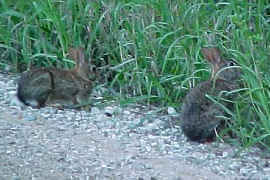 Quite a few of our better known wild animals were introduced to Britain by man, either deliberately, or accidentally in cargo ships. For example, rabbits were brought to Britain by the Normans in the 12th century because they were a useful source of meat and skins. Of our 60 present-day species of mammals, 18 have been introduced.
Quite a few of our better known wild animals were introduced to Britain by man, either deliberately, or accidentally in cargo ships. For example, rabbits were brought to Britain by the Normans in the 12th century because they were a useful source of meat and skins. Of our 60 present-day species of mammals, 18 have been introduced.
Many of our largest mammals, fish and birds of prey were hunted to extinction or died out as their habitats were destroyed. Wolves, lynx, reindeer, moose, wild boar, beavers and bears used to roam the countrysides before we spread out into the countryside and changed woodlands and wilderness areas.
The plants of Britain have followed a similar historical pattern. For example, before the British Isles were separated from the Continent, there were 32 established species of broad-leaved trees, 3 species of conifer and a few shrubs. All other trees now growing were introduced by man - many hundreds of species of trees and shrubs may now be found growing in Britain.
Britain's Changing Countryside
By the time Britain became an island, most of the land was blanketed by an extensive forest of broad-leaved trees, mainly oak and elm. The forest canopy was so dense that very few flowering ground plants could survive beneath it.
Through the centuries, the forests have been cut down to make room for human needs. In about 3,500 BC the early farmers found about two-thirds of Britain covered by trees but in 1086 AD the Doomsday Book (compiled for William the Conqueror as the result of a nationwide survey of resources) recorded that only 20 per cent of England was still covered with trees. Nowadays, the only large areas of natural woodland to be seen are the original royal hunting preserves, designated by the Normans as protected forests, such as the New Forest in Hampshire. Otherwise there are only small patches of woodlands which may be remnants of the ancient broadleaved forests.
Today, our countryside is mainly made up of grassland but very little is natural grassland where wild flowers can flourish. Most fields contain special grasses to feed cattle for humans. Almost all countryside habitats have either been created or changed by humans, including hedgerows, heathlands, high moors, marshes, fens, water meadows, ponds, rivers and streams. Over the years, these habitats have been reduced quite drastically to make way for the needs of an ever-expanding human population. As a result the wildlife, which those habitats support, lose their source of food and shelter.
Other human activities have affected the countryside too. During the last part of the Twentieth century vast quantities of poisonous chemicals, such as pesticides (to kill insect pests), herbicides (to kill weeds) and fertilizers (to increase the yield of crops), have been sprayed onto the land. Some of these are washed by the rain into rivers, streams and ponds, polluting the water - thus wildlife on both land and in water is destroyed.
Wildlife in Danger
What has this continual habitat destruction meant for Britain’s wild animals and plants? The obvious answer is that their numbers have declined and some of them have become endangered - that is, they are threatened with extinction.
Indeed, over the last 1,000 years several native animals have become extinct in Britain, mainly as a result of human activities. However, for food and sport, and destruction of their habitat, caused the extinction of the brown bear and auroch (a wild ox) by the 10th century, the beaver in the 12th century, the wild boar by the end of the 17th century and the wolf by the end of the 18th century. There have been other animals too and twenty of our native species of plants have become extinct during the last three hundred years. Many more of our wild animals and plants could become extinct unless we take care.
Here are some short case histories of six of Britain’s endangered species...
European Otter
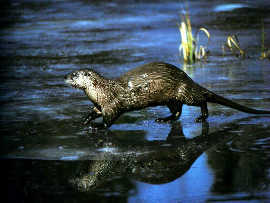 The otter is a member of the weasel family which, although a land mammal, has adapted to life in the water. It lives by rivers, marshes, lakes, and along some coastlines and sheltered estuaries, hunting at night for mainly fish.
The otter is a member of the weasel family which, although a land mammal, has adapted to life in the water. It lives by rivers, marshes, lakes, and along some coastlines and sheltered estuaries, hunting at night for mainly fish.
During the day, the otter rests in thick vegetation on the river bank, or in a hole, called a holt, amongst the roots of a tree. The otter has no enemies except for humans who used to hunt it for fur, for sport or to protect fish stocks.
Until the 1950s otters were widespread across Britain but in the late 1950s and early 1960s they suffered a sudden crash in numbers. They disappeared completely from many areas and in England small populations are now found only in the South-West and in East Anglia. In Scotland and Wales, otters are more numerous, although not abundant.
Reasons for decline - farmers began to use organochlorine pesticides in the 1950s and these were washed into rivers and worked their way up the food chains. These either killed the otters or affected their breeding and immunity to disease. Water pollution from herbicides, fertilizers, farm slurry, industrial effluent and sewage also added to the problem. Modern farming methods have destroyed much of the otter’s riverside habitat and boating and fishing have disturbed the shy otter in previously quiet waterways. In January 1978 the otter was declared so rare that it was given legal protection and in 1981 the practice of otter hunting with specially bred dogs named otter hounds, was banned.
The future - organochlorine pesticides are now banned and freshwater pollution has been reduced. Conservationists have encouraged landowners to manage their land with otters in mind and they have also organised the protection of stretches of well-wooded riverbanks to safeguard the otters living there.
The Otter Trust, based in Suffolk, has, since 1983, bred otters and reintroduced them into now suitable areas where they were previously wiped out. Thanks to the banning of harmful pesticides, protective laws and better habitat management the otter is now confirmed present in all England's counties - a happy ending for the otter, extinct in most of the country only 60 years ago.
The Peregrine Falcon
 The peregrine falcon is the largest British falcon, living in wild uplands and rocky coasts. It may be spotted in the Scottish Highlands and Islands, in the Lake District, Devon, Cornwall, Wales and Ireland. It is an impressive hunter, its main prey being birds up to the size of pigeons which it can catch in mid-flight. Peregrines declined in numbers drastically during the 1950s and they are a specially protected bird under the Wildlife and Countryside Act. There are now about 1,500 pairs in Britain, including 24 in London.
The peregrine falcon is the largest British falcon, living in wild uplands and rocky coasts. It may be spotted in the Scottish Highlands and Islands, in the Lake District, Devon, Cornwall, Wales and Ireland. It is an impressive hunter, its main prey being birds up to the size of pigeons which it can catch in mid-flight. Peregrines declined in numbers drastically during the 1950s and they are a specially protected bird under the Wildlife and Countryside Act. There are now about 1,500 pairs in Britain, including 24 in London.
Reasons for decline - the introduction of organochlorine pesticides, such as DDT, had a disastrous effect on all Britain’s birds of prey. These poisons accumulated in the food chain, and, the peregrines, being at the top of the food chain, accumulated such large quantities of the substances from their prey that their breeding success was affected. The eggs were either infertile or they had fragile shells, easily broken. Peregrines have also suffered from persecution by gamekeepers and egg collectors.
The future - organochlorine pesticides were finally banned in 1976 and since then the peregrine falcon population has begun to recover. Some individual birds nesting in areas where they could be vulnerable to egg collectors are guarded by volunteers.
The Smooth Snake
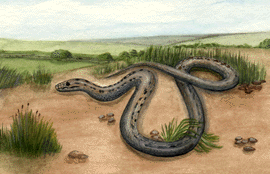 The smooth snake is one of Britain’s rarest animals, found only on some lowland heaths in southern England. It is a shy reptile, slim in shape and greyish-brown in colour, growing up to 60cm in length. Lizards are the smooth snake’s favourite prey, especially the sand lizard which is also an endangered reptile. It will also eat other snakes, small mammals and invertebrates. Non-poisonous, the smooth snake holds its victim in its coiled body while it gets into position to swallow the prey head first.
The smooth snake is one of Britain’s rarest animals, found only on some lowland heaths in southern England. It is a shy reptile, slim in shape and greyish-brown in colour, growing up to 60cm in length. Lizards are the smooth snake’s favourite prey, especially the sand lizard which is also an endangered reptile. It will also eat other snakes, small mammals and invertebrates. Non-poisonous, the smooth snake holds its victim in its coiled body while it gets into position to swallow the prey head first.
Reasons for decline - lowland heaths have been under increasing pressure from housing development, farmers, foresters, walkers and fires. As these endangered habitats have decreased in size, the smooth snake has decreased in numbers.
The future - the survival of the smooth snake in Britain depends entirely on whether or not the lowland heaths can be preserved. A few areas have been designated as special nature reserves but these must be carefully managed i.e. young trees removed (a heath will turn into woodland if left entirely alone) and walkers restricted to paths etc. Reintroduction of the species has occured in several parts of the south. Smooth snakes can now be found in Dorset, Devon, Hampshire, Surrey and West Sussex.
The Great Crested Newt
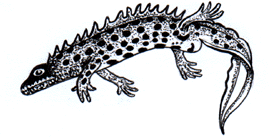 The great crested, or warty, newt, is the largest of the European newts. It is an amphibian and therefore a close relative of frogs and toads. Amphibians have a soft, porous skin which must be kept moist all the time, so newts never stray far from water. On land, the newts hide under stones or logs by day, coming out at night to hunt for worms, insects, slugs and snails among damp grass or leaves. In spring, the newts return to ponds to breed and there they eat tadpoles (including their own), frog-spawn and small invertebrates. Over the years, great crested newt numbers have been declining and they are protected by law, officially classed as an endangered species.
The great crested, or warty, newt, is the largest of the European newts. It is an amphibian and therefore a close relative of frogs and toads. Amphibians have a soft, porous skin which must be kept moist all the time, so newts never stray far from water. On land, the newts hide under stones or logs by day, coming out at night to hunt for worms, insects, slugs and snails among damp grass or leaves. In spring, the newts return to ponds to breed and there they eat tadpoles (including their own), frog-spawn and small invertebrates. Over the years, great crested newt numbers have been declining and they are protected by law, officially classed as an endangered species.
Reasons for decline - fifty years ago there were twice as many ponds in the countryside than there are today. Most of Britain’s original ponds have been destroyed by pollution, or drained and filed in to make way for buildings and farmland. This has meant that the great crested newt has lost many of its essential breeding sites. In the past the newts were collected in large numbers, reducing the wild population even further.
The future - over recent years there has been an ever-increasing interest in garden ponds and the creation of these has provided the newts with much-needed habitats. This, together with legal protection, may help the great crested newt population to recover.
The Swallowtail Butterfly
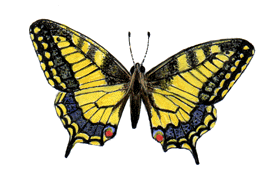 The beautiful, creamy-yellow and black swallowtail is Britain’s most exotic butterfly but it has become increasingly rare since the 19th century. For a long time it has been confined to parts of East Anglia where its only food plant, milk parsley, flourishes. The butterfly’s favourite habitat is wetland, such as the moist bog and fen found in eastern England. The swallowtail is common throughout the rest of Europe, Africa and Asia, but the British swallowtail britannicus is a unique subspecies found nowhere else in the world.
The beautiful, creamy-yellow and black swallowtail is Britain’s most exotic butterfly but it has become increasingly rare since the 19th century. For a long time it has been confined to parts of East Anglia where its only food plant, milk parsley, flourishes. The butterfly’s favourite habitat is wetland, such as the moist bog and fen found in eastern England. The swallowtail is common throughout the rest of Europe, Africa and Asia, but the British swallowtail britannicus is a unique subspecies found nowhere else in the world.
Reasons for decline - the swallowtail and the milk parsley thrived for thousands of years in the wetlands of eastern England, but from the 18th century onwards this important habitat has been slowly but surely drained and replaced by wheat fields. The moisture-loving milk parsley has died out in many areas and the swallowtail, relying exclusively on this plant, has disappeared along with it.
The future - despite several attempts over the past forty years to increase the butterfly’s range and population, the swallowtail is still very rare. As a result of research carried out during these attempts, it has been discovered that it is essential that the ground is kept very moist to keep both milk parsley and butterfly alive.
Wicken Fen, near Cambridge, was another stronghold until the early 1950s when all the swallowtails disappeared. After many failures to reintroduce them, it was eventually discovered that the peaty soil had been slowly drying out because all the surrounding fens had been drained and led to a drop in the water table level.
Current populations in the east, at present it can only be found in the Norfolk Broads, are considered stable but this is reliant on continous management of their habitat.
Lady's Slipper Orchid
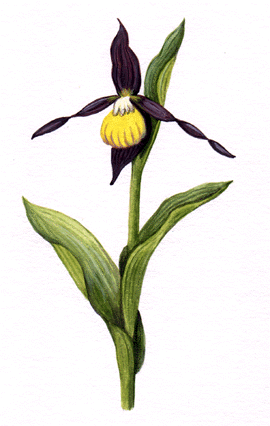 The large, maroon and yellow flowers of the Lady’s slipper make it quite unlike any other British orchid. Its natural habitat is woodland. Today it is an extremely rare plant.
The large, maroon and yellow flowers of the Lady’s slipper make it quite unlike any other British orchid. Its natural habitat is woodland. Today it is an extremely rare plant.
Reasons for decline - large areas of natural woodland have been cleared, particularly during the last century, and many of the plants which grew in them have become rare or extinct. The beautiful Lady’s slipper is one of them and now only a few plants grow at one site in Yorkshire. Many of them were dug up by collectors in the past.
The future - the one and only site where the plants grow must be kept secret and carefully protected. It is a criminal offence for anyone to uproot any wild plant without permission of the landowner, and, in the case of extremely rare plants such as the Lady’s slipper, it is illegal to collect any part of these, even the seeds. If anyone is caught doing so, they may be fined. It is very important to protect the habitats where rare plants grow.
Ideas For Projects
1. Make a nature reserve: Most of us have a garden of some kind, which, with a little thought, can be made into a suitable, much-needed habitat for some of our wildlife. Most animals and plants found in the garden will be common species, although a pond may attract great crested newts and a specially made box offers a roost for our rare bats. It has to be remembered that the common wildlife of today could easily become the rarities of tomorrow.
Create as many different habitats as you can. A hedge planted with native shrubs will give shelter and food for all sorts of animals; nectar-rich flowers will provide food for butterflies and other insects; logs, stones and dead leaves provide homes for a range of minibeasts. Birds will appreciate a well-stocked table of food during the winter and nest boxes in the spring. You may like to keep a seasonal diary, making note of the wildlife using your garden.
2. Learn as much as you can about British animals, plants and their habitats. An excellent way of doing this is to join a local wildlife group such as Watch, the junior branch of The National Wildlife Trust; as well as adding to your general knowledge you may be able to get involved with some practical conservation work in the countryside.
3. Try to find out if there are any endangered animals or plants living in your country or county. If so, what is being done to help them survive?
4. Imagine you are an animal or plant belonging to an endangered species. Describe your habitat and what things are threatening your existence. Is there anything being done to help you?
Credits
Image: Disappearing Wildlife by bzd1
Information sourced from:
Norfolk Wildlife Trust (2014), Wildlife in Norfolk, Swallowtail Butterfly, Papilio Machaon Where to see [online], Available from: https://www.norfolkwildlifetrust.org.uk/wildlife-in-norfolk/speciesexplorer/terrestrial-invertebrates/swallowtail-butterfly [accessed 28/05/2015].
 Quite a few of our better known wild animals were introduced to Britain by man, either deliberately, or accidentally in cargo ships. For example, rabbits were brought to Britain by the Normans in the 12th century because they were a useful source of meat and skins. Of our 60 present-day species of mammals, 18 have been introduced.
Quite a few of our better known wild animals were introduced to Britain by man, either deliberately, or accidentally in cargo ships. For example, rabbits were brought to Britain by the Normans in the 12th century because they were a useful source of meat and skins. Of our 60 present-day species of mammals, 18 have been introduced.
 The otter is a member of the weasel family which, although a land mammal, has adapted to life in the water. It lives by rivers, marshes, lakes, and along some coastlines and sheltered estuaries, hunting at night for mainly fish.
The otter is a member of the weasel family which, although a land mammal, has adapted to life in the water. It lives by rivers, marshes, lakes, and along some coastlines and sheltered estuaries, hunting at night for mainly fish. The peregrine falcon is the largest British falcon, living in wild uplands and rocky coasts. It may be spotted in the Scottish Highlands and Islands, in the Lake District, Devon, Cornwall, Wales and Ireland. It is an impressive hunter, its main prey being birds up to the size of pigeons which it can catch in mid-flight. Peregrines declined in numbers drastically during the 1950s and they are a specially protected bird under the Wildlife and Countryside Act. There are now about 1,500 pairs in Britain, including 24 in London.
The peregrine falcon is the largest British falcon, living in wild uplands and rocky coasts. It may be spotted in the Scottish Highlands and Islands, in the Lake District, Devon, Cornwall, Wales and Ireland. It is an impressive hunter, its main prey being birds up to the size of pigeons which it can catch in mid-flight. Peregrines declined in numbers drastically during the 1950s and they are a specially protected bird under the Wildlife and Countryside Act. There are now about 1,500 pairs in Britain, including 24 in London. The smooth snake is one of Britain’s rarest animals, found only on some lowland heaths in southern England. It is a shy reptile, slim in shape and greyish-brown in colour, growing up to 60cm in length. Lizards are the smooth snake’s favourite prey, especially the sand lizard which is also an endangered reptile. It will also eat other snakes, small mammals and invertebrates. Non-poisonous, the smooth snake holds its victim in its coiled body while it gets into position to swallow the prey head first.
The smooth snake is one of Britain’s rarest animals, found only on some lowland heaths in southern England. It is a shy reptile, slim in shape and greyish-brown in colour, growing up to 60cm in length. Lizards are the smooth snake’s favourite prey, especially the sand lizard which is also an endangered reptile. It will also eat other snakes, small mammals and invertebrates. Non-poisonous, the smooth snake holds its victim in its coiled body while it gets into position to swallow the prey head first. The great crested, or warty, newt, is the largest of the European newts. It is an amphibian and therefore a close relative of frogs and toads. Amphibians have a soft, porous skin which must be kept moist all the time, so newts never stray far from water. On land, the newts hide under stones or logs by day, coming out at night to hunt for worms, insects, slugs and snails among damp grass or leaves. In spring, the newts return to ponds to breed and there they eat tadpoles (including their own), frog-spawn and small invertebrates. Over the years, great crested newt numbers have been declining and they are protected by law, officially classed as an endangered species.
The great crested, or warty, newt, is the largest of the European newts. It is an amphibian and therefore a close relative of frogs and toads. Amphibians have a soft, porous skin which must be kept moist all the time, so newts never stray far from water. On land, the newts hide under stones or logs by day, coming out at night to hunt for worms, insects, slugs and snails among damp grass or leaves. In spring, the newts return to ponds to breed and there they eat tadpoles (including their own), frog-spawn and small invertebrates. Over the years, great crested newt numbers have been declining and they are protected by law, officially classed as an endangered species. The beautiful, creamy-yellow and black swallowtail is Britain’s most exotic butterfly but it has become increasingly rare since the 19th century. For a long time it has been confined to parts of East Anglia where its only food plant, milk parsley, flourishes. The butterfly’s favourite habitat is wetland, such as the moist bog and fen found in eastern England. The swallowtail is common throughout the rest of Europe, Africa and Asia, but the British swallowtail britannicus is a unique subspecies found nowhere else in the world.
The beautiful, creamy-yellow and black swallowtail is Britain’s most exotic butterfly but it has become increasingly rare since the 19th century. For a long time it has been confined to parts of East Anglia where its only food plant, milk parsley, flourishes. The butterfly’s favourite habitat is wetland, such as the moist bog and fen found in eastern England. The swallowtail is common throughout the rest of Europe, Africa and Asia, but the British swallowtail britannicus is a unique subspecies found nowhere else in the world. The large, maroon and yellow flowers of the Lady’s slipper make it quite unlike any other British orchid. Its natural habitat is woodland. Today it is an extremely rare plant.
The large, maroon and yellow flowers of the Lady’s slipper make it quite unlike any other British orchid. Its natural habitat is woodland. Today it is an extremely rare plant.